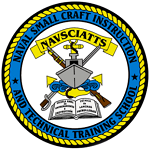In June 1969, SCIATT was transferred to the U.S. Navy, re-designated Small Craft Instruction and Technical Team, and placed under the direction of U.S. Naval Station, Panama Canal, as a department. With continual training demands and increasingly large enrollment, the school was informally established as a Naval Shore Activity on October 19, 1982. OPNAVNOTE 5450 009B2E3/314089 of October 29, 1982, officially established NAVSCIATTS as a shore activity on U.S. Naval Base, Panama, effective October 19, 1982. NAVSCIATTS was assigned to Commander, Training Command Atlantic Fleet, as a functional command for the Chief of Naval Education and Training (CNET) at that time. Continued success and further expansion led to NAVSCIATTS official establishment as a Naval Shore Command (the first Commanding Officer was Commander Richard James Flanagan) on July 21, 1983, under then-President Ronald Reagan’s directives to enhance U.S. security forces relationships in Latin America and the Caribbean. NAVSCIATTS remained a component of CNET until disestablished in January 1999 (CNO LTR N09B22C/20 NOV. 1998) as a result of the closure of Rodman Naval Station in the Republic of Panama (Torrijos-Carter Treaty). The subsequent decision by Chief of Naval Operations in response to Fiscal Year 1999 Program Budget Decision (PBD) 715R signed December 22, 1998, to placed NAVSCIATTS under Naval Special Warfare (NSW) via OPNAV Notice 5450, 7 March 2001, with direction to relocate, establish and operate NAVSCIATTS at NASA's John C. Stennis Space Center in Mississippi. PBD 715R provided the resources to Navy for reconstitution of the riverine training capability. An October 1, 1999, ceremony at Stennis Space Center shifted C2 from under CNET, re-established and commissioned NAVSCIATTS an echelon IV shore command OPCON and ADCON through Commander, Naval Special Warfare Center and Naval Special Warfare Command to USSOCOM.
In 2006, the Commander of USSOCOM assigned NAVSCIATTS the mission: “NAVSCIATTS conducts Foreign Internal Defense (FID) in support of Combatant Commanders in accordance with Commander, U.S. Special Operations Command, priorities using Mobile Training Teams (MTTs) and in-residence training to prepare partner nation forces to conduct small craft operations in riverine or littoral environments.
| Co-located with Special Boat Team - Twenty Two on Stennis Space Center, NAVSCIATTS is situated on the NSW Western Maneuver Area (WMA) training range which is composed of some of the finest riverine and littoral training areas in the world. NAVSCIATTS first day of classes were held January 10, 2000. Following the Secretary of Defense’s designation of USSOCOM as Joint Proponent for Security Force Assistance (SFA) on September 19, 2008, Naval Special Warfare Command decided on December 17, 2008, to shift NAVSCIATTS immediate supervisor in chain (ISIC) from NAVSPECWARCEN to NSWG-4 effective April 1, 2009. This decision has resulted in improved maritime SFA training integration with Special Boat Team operational support to Naval Special Warfare Units, Theater Special Operations Commands, Combatant Commanders and Partner Nation maritime units worldwide. The 2019 National Defense Authorization Act, titled after Sen. John S. McCain, officially authorized NAVSCIATTS to provide to the military and other security forces of one or more friendly foreign countries education and training under any other provision of law related to naval small craft instruction and training and to increase: professionalism, readiness, and respect for human rights through formal courses of instruction or mobile training teams for the operation, employment, maintenance and logistics of specialized equipment; participation in joint exercises; or coalition of international military operations; and improved interoperability between the armed forces; and the military and other security forces of the one or more friendly foreign countries. On 1 April, 2019, the Secretary of Defense designated the Secretary of the Navy as Executive Agent. A 28 March 2024 Under Secretary of the Navy Memorandum for the Assistant Secretary of Defense for Special Operations and Low Intensity Conflict to inform the Department of the Navy's (DON) plan for sustainment of NAVSCIATTS, continued alignment of the school with the National Defense Strategy, and resources programmed for ensuring a successful NAVSCIATTS. In addition, the DON supported transition of NAVSCIATTS from a Special Operations Forces (SOF) Major Force Program (MFP)-11 resourced model to a MFP-2 DON general purpose forces resourced NAVSCIATTS starting in FY25. Command and control of MFP-2 resourced NAVSCIATTS goes through Naval Special Warfare (NSW) Group Four and Naval Special Warfare Command to the Chief of Naval Operations.
|

